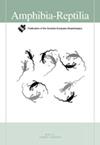Genetic data to describe the hybrid zone between Bufo bufo (Linnaeus, 1758) and Bufo verrucosissimus (Pallas, 1814) in northeastern Türkiye
IF 1.3
4区 生物学
Q3 ZOOLOGY
引用次数: 0
Abstract
Hybrid zones are geographic areas where individuals from distinct taxa meet, mate, and hybridize. These zones may have complex histories, but many of them originated relatively recently, during climatic oscillations in the Quaternary, following range shifts of formerly isolated, well-differentiated lineages. The Bufo bufo species group comprises four species distributed over the Western Palearctic. Whereas the contact zone between Bufo bufo and B. spinosus in western Europe has been well characterized, little is known about other species contacts. Here we focused on the contact between B. verrucosissimus and B. bufo in northeastern Türkiye, using mtDNA and microsatellite markers to describe genetic structure and patterns of admixture in the hybrid zone based on Bayesian clustering and cline analyses. Both species meet in a narrow contact zone at Rize province, with restricted introgression suggesting barriers to hybridization consistent with species status. Spatial population genetic analyses of microsatellite data pinpoint a possible enclave population of B. bufo at the Borçka district in Artvin province, isolated within the B. verrucosissimus range. The centers of the microsatellite and mtDNA-based clines are slightly displaced, with B. verrucosissimus mtDNA introgressing about 33 km W of the nuclear contact. Hybrid zone dynamics seem to be associated with range shifts mediated by Pleistocene glacial cycles and/or sex-biased dispersal.描述斯里兰卡东北部Bufo Bufo (Linnaeus, 1758)和Bufo verrucosissimus (Pallas, 1814)杂交带的遗传数据
杂交带是来自不同分类群的个体相遇、交配和杂交的地理区域。这些地区可能有复杂的历史,但它们中的许多都是在第四纪的气候振荡期间相对较近地形成的,随着以前孤立的、分化良好的谱系的范围转移。的以以种群包括四个物种分布在西方古北区的。在西欧,人们对Bufo Bufo与B. spinosus的接触区已经有了很好的描述,但对其他物种的接触却知之甚少。本研究利用mtDNA和微卫星标记,基于贝叶斯聚类分析和梯度分析,对杂交带的遗传结构和杂交模式进行了描述。这两个物种在Rize省的一个狭窄的接触区相遇,有限的渐渗表明杂交障碍与物种状况一致。微卫星数据的空间种群遗传分析确定了在阿尔特文省borka地区可能存在的bufo飞地种群,该种群被隔离在B. verrucosissimus范围内。微卫星和以mtDNA为基础的线的中心有轻微的偏移,疣状芽孢杆菌的mtDNA向核接触处约33 km W的地方渗入。混合带动力学似乎与更新世冰期旋回和/或性别偏倚扩散介导的范围移动有关。
本文章由计算机程序翻译,如有差异,请以英文原文为准。
求助全文
约1分钟内获得全文
求助全文
来源期刊

Amphibia-Reptilia
生物-动物学
CiteScore
3.10
自引率
6.20%
发文量
39
审稿时长
6-12 weeks
期刊介绍:
Amphibia-Reptilia is a leading European multi-disciplinary journal devoted to most of the aspects of herpetology: ecology, behaviour, evolution, conservation, physiology, morphology, paleontology, genetics, and systematics.
Amphibia-Reptilia publishes high quality original papers, short-notes, reviews, book reviews and news of the Societas Europaea Herpetologica (SEH). The Societas Europaea Herpteologica (SEH) website is located at: www.seh-herpetology.org.
 求助内容:
求助内容: 应助结果提醒方式:
应助结果提醒方式:


